You’ve mastered basic jewelry-making techniques, but granulation remains the field’s most challenging discipline. This ancient art demands absolute precision—one degree too hot and your carefully crafted granules will collapse into molten pools. You’ll need specialized equipment, steady hands, and an understanding of metallurgy that goes beyond traditional smithing. Most jewelers avoid granulation entirely, yet those who’ve earned certification command premium prices for their intricate work. The question isn’t whether you can learn it.
Mastering the Ancient Art of Metal Granulation
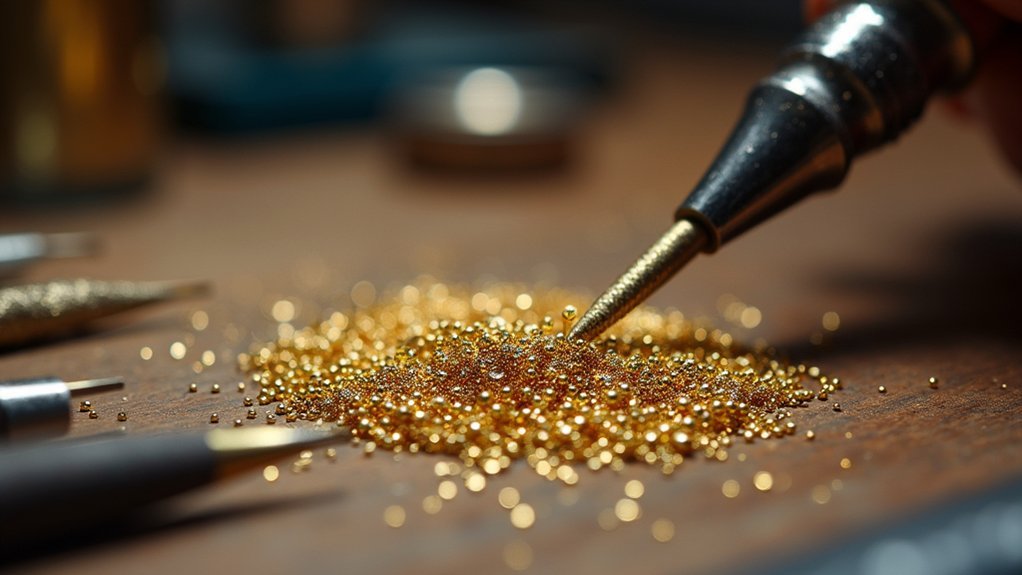
When you master metal granulation, you’re reviving a technique that’s captivated artisans for over 4,000 years. This sophisticated goldsmithing method involves fusing tiny metal granules onto surfaces without traditional soldering, creating intricate decorative patterns that showcase exceptional craftsmanship.
Your granulation journey requires precise temperature control, typically maintaining 900°C to 1000°C to achieve proper bonding without melting granules into the base metal.
You’ll need to create uniform-sized granules from fine silver or gold through careful melting and shaping techniques.
Flux becomes your essential ally, preventing oxidation while improving surface adhesion during the fusing process.
Through dedicated Jewelry Training, you’ll develop the expertise to incorporate detailed textures and designs that greatly enhance your pieces’ aesthetic value and marketability, distinguishing your work in competitive markets.
Essential Tools and Materials for Professional Granulation Work
Five fundamental tools form the backbone of professional granulation work, each serving a vital role in achieving flawless results.
You’ll need a high-quality torch for precise heating control and specialized granulation tweezers for handling delicate granules.
Essential tools also include fine silver and Argentium silver sheets to create uniform granules with consistent sizing.
Fine silver and Argentium silver sheets are indispensable for producing consistently sized, uniform granules in professional metalworking applications.
Your granulation hand tool kit should contain soldering pads, flux, and fusing materials to facilitate effective processes.
Don’t forget preparation tools like files and sanding papers – they’re essential for creating the ideal base surface texture that guarantees proper granule adhesion.
Advanced Fusing Temperatures and Heat Control Methods
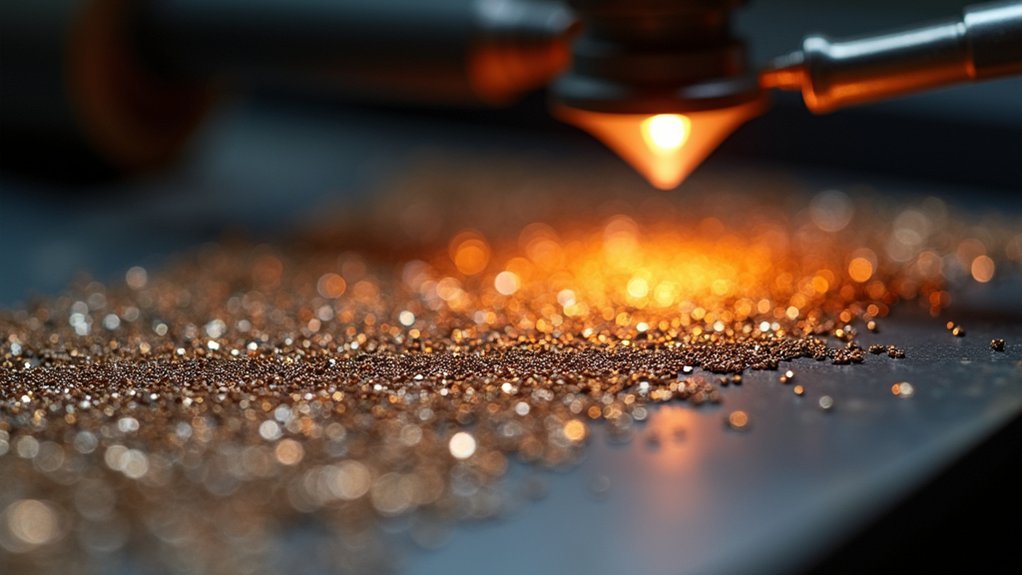
When you’re working with advanced granulation, you’ll need to master temperature precision control between 700°C to 850°C to achieve successful fusing without melting your base metal.
Understanding heat distribution patterns becomes essential as you direct your torch’s adjustable flame to create even heating across your work surface.
You’ll find that fusing point mastery requires maintaining that ideal temperature for just seconds—too long and you’ll compromise your piece’s integrity.
Temperature Precision Control
Although granulation appears deceptively simple, mastering temperature precision control separates amateur attempts from professional-quality results.
In granulation techniques, you’ll need to maintain Fine Silver’s fusing temperature between 1,300°F to 1,450°F (704°C to 788°C) for ideal adhesion without melting your granules.
You can achieve effective heat control using a torch with fine flame precision or employing a kiln for even distribution.
Don’t overlook flux’s vital role—it lowers surface tension, enabling better granule bonding at reduced temperatures.
Timing’s critical; maintain even temperature for just seconds to avoid overheating and distortion.
Advanced practitioners use thermocouples or infrared thermometers for real-time monitoring, allowing precise adjustments during fusing to achieve consistently professional results in your granulation work.
Heat Distribution Patterns
Because heat distribution directly determines granulation success, you’ll need to master how thermal energy flows across your silver surface to avoid the random hot spots that cause granule distortion.
Understanding heat distribution patterns becomes critical when working with advanced fusing temperatures between 650°C to 800°C. You can achieve targeted heating using torches with adjustable flame settings, focusing thermal energy precisely where needed. For larger pieces requiring consistent heat distribution patterns, kilns provide superior temperature stability compared to manual torching methods.
| Heat Control Method | Temperature Range | Best Application |
|---|---|---|
| Adjustable Torch | 650°C-750°C | Targeted areas |
| Kiln Heating | 700°C-800°C | Large pieces |
| Heat Sink | Variable | Preventing overheating |
| Reflective Surfaces | Variable | Controlling flow |
| Manual Control | 650°C-775°C | Detailed work |
Practice different heat application techniques using heat sinks and reflective surfaces to control thermal flow effectively during granulation.
Fusing Point Mastery
While heat distribution establishes the foundation for granulation work, achieving perfect fusing points demands you recognize the precise moment when silver reaches its ideal bonding temperature without crossing into complete melting.
You’ll need to master fusing temperatures ranging from 1,600°F for Fine Silver to 1,700°F for Argentium Silver. Watch for that critical soft orange glow—it’s your visual cue for ideal granulation conditions.
Control heat duration carefully; prolonged exposure destroys your granules while insufficient time creates weak bonds. Apply proper flux to prevent oxidation and guarantee clean fusions.
Use kilns or adjustable torches to maintain consistent temperatures across your entire piece, preventing hot spots that compromise granule integrity.
Creating Uniform Granules Through Precision Techniques
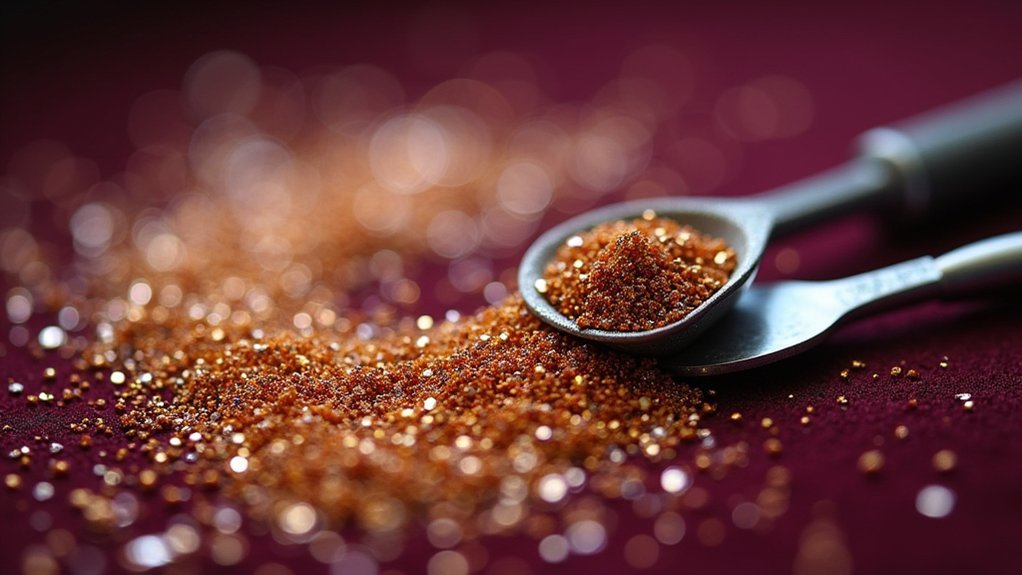
Once you’ve selected your precious metal—whether Fine Silver or Argentium Silver—the journey toward perfect granulation begins with creating consistently sized spherical granules.
You’ll achieve uniform results by melting small pieces of precious metals and allowing them to form natural spheres through surface tension. Cut your metal into equal-sized fragments before heating to guarantee consistency.
Control your torch movement carefully, maintaining steady heat until each piece forms a perfect sphere. You’ll notice the metal naturally rounds itself when heated properly.
Avoid overheating, which creates irregular shapes or overly large granules. Practice measuring techniques help maintain uniformity across batches.
Sort your completed granules by size using different mesh screens, separating them into groups for specific granulation applications requiring precise dimensional consistency.
Surface Preparation and Pattern Design Strategies
Before arranging your carefully crafted granules into stunning patterns, you must prepare the base metal surface with meticulous attention to detail.
Surface preparation creates the foundation for successful granulation by establishing a clean, even area where granules can properly adhere during fusing. Remove all oxidation, oils, and debris using fine abrasives or pickling solutions.
A pristine metal foundation ensures optimal granule adhesion—eliminate every trace of oxidation, oils, and contaminants before beginning your decorative work.
Understanding flux’s role becomes essential during this phase. It reduces oxidation and improves metal flow when heated, creating stronger bonds between granules and your base surface.
Pattern design requires strategic thinking about visual impact. You’ll achieve consistent results using uniform-sized granules arranged in spirals, geometric shapes, or random clusters.
Control fusing temperatures precisely to secure granules without melting your base metal, ensuring your patterns maintain their intended aesthetic appeal.
Certification Requirements and Assessment Standards
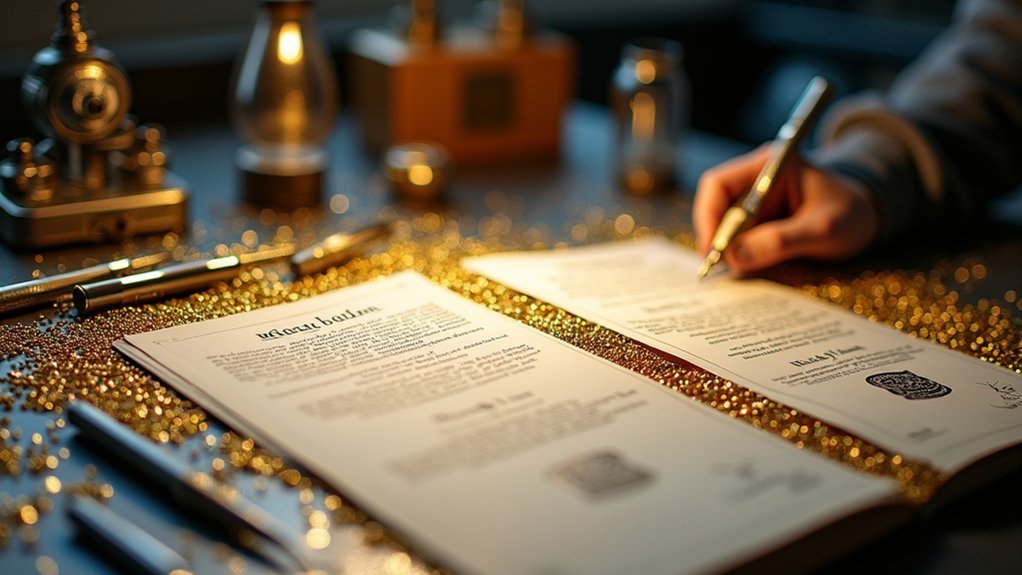
You’ll need to meet specific technical skill benchmarks that demonstrate your mastery of uniform granule creation and systematic arrangement techniques.
Your portfolio submission must showcase both technical precision and creative application of granulation methods in personal jewelry designs.
Professional assessment criteria focus on your understanding of flux usage, fusing temperatures, and finishing methodologies as evaluated by experienced tutors through continuous feedback sessions.
Technical Skill Benchmarks
As you pursue certification in Advanced Granulation Techniques, you’ll need to meet specific technical skill benchmarks that demonstrate your mastery of this intricate metalworking art.
These standards guarantee you’re prepared for professional jewelry applications and can consistently deliver high-quality results.
Your certification evaluation will focus on three core competencies:
- Granule Creation and Placement – You must produce uniform-sized granules and demonstrate precise arrangement techniques on prepared base surfaces.
- Process Knowledge – You’ll need to show understanding of flux application, proper fusing temperatures, and finishing methodologies.
- Project Execution – Your final submission must showcase advanced techniques while meeting professional standards.
Professional jewellers will review your work, providing personalized feedback to help refine your skills and guarantee you meet industry expectations for excellence.
Portfolio Submission Standards
Three distinct projects form the foundation of your portfolio submission, each designed to showcase your mastery of granulation techniques while demonstrating creative innovation.
Your portfolio submissions must include thorough documentation detailing the techniques used, material selections, and creative processes for every piece. You’ll need to demonstrate proficiency in granule creation, strategic arrangement, and successful fusing methods alongside professional finishing techniques.
Assessment evaluators examine both technical execution and artistic expression within your granulation work. You’ll receive detailed, personalized feedback addressing strengths and areas for improvement.
Meeting established deadlines isn’t optional—strict adherence guarantees timely evaluation and continuous skill development. Your documentation should clearly articulate decision-making processes, challenge solutions, and technical approaches.
This thorough assessment framework guarantees thorough evaluation while supporting your continued advancement in specialized granulation mastery.
Professional Assessment Criteria
Moving beyond submission requirements, professional certification demands mastery of specific technical benchmarks that define expertise in advanced granulation work.
You’ll face extensive practical assessments that evaluate your ability to execute complex granulation techniques with precision and artistry.
Your professional evaluation encompasses three critical competency areas:
- Technical Proficiency – Creating uniform-sized granules, preparing base surfaces properly, and demonstrating mastery of fusing temperatures and methodologies
- Application Skills – Effectively arranging granules on various surfaces and successfully applying flux throughout the granulation process
- Creative Excellence – Integrating granulation techniques seamlessly into innovative jewelry designs while maintaining adherence to established principles
Throughout your certification journey, you’ll receive ongoing mentorship and structured feedback sessions.
These support systems guarantee you’re progressing effectively toward professional standards while developing the expertise that distinguishes certified granulation specialists in the jewelry industry.
Career Opportunities for Certified Granulation Specialists

Numerous career paths open up once you’ve earned your certification in granulation techniques.
You’ll find exciting career opportunities in high-end jewelry brands and independent artisan studios that value exceptional craftsmanship. The bespoke jewellery market particularly seeks certified specialists who can create unique, intricate designs that set pieces apart from mass-produced alternatives.
Your certification enhances your portfolio, attracting clients who specifically want specialized granulation work.
You’ll benefit from the growing trend toward personalized, handmade jewelry, which has greatly increased demand for your expertise. This surge creates excellent prospects for business ownership if you’re entrepreneurial.
Additionally, you can diversify your income by teaching workshops and classes, sharing your advanced skills with aspiring jewelers while building your reputation in the craftsman community.
Frequently Asked Questions
How Long Does It Typically Take to Complete the Granulation Certification Program?
You’ll typically complete the granulation certification program in 6-12 months, depending on your schedule and pace. You’re learning intricate metalworking techniques that require practice, so don’t rush the process for best results.
What Is the Cost of Enrollment for the Advanced Granulation Techniques Course?
You’ll find enrollment costs vary considerably between institutions, typically ranging from $800 to $2,500. You’re investing in specialized equipment access, expert instruction, and extensive materials that’ll advance your metalworking skills greatly.
Are There Any Prerequisite Skills or Certifications Required Before Applying?
You’ll need basic metalsmithing skills and soldering experience before applying. Most programs require completing foundational jewelry courses or demonstrating equivalent hands-on experience with precious metals and torch work.
Can the Certification Be Completed Entirely Online or Is In-Person Attendance Mandatory?
You’ll need to attend hands-on workshops in person since granulation requires physical practice with torches, metals, and microscopic techniques. Online theory modules complement the certification, but practical skills can’t be developed remotely.
How Often Do I Need to Renew My Granulation Certification Credentials?
You’ll typically need to renew your credentials every three to five years, depending on the certifying organization’s requirements. Most programs require continuing education credits or skill demonstrations to maintain your active certification status.
In Summary
You’ve now explored the extensive pathway to mastering advanced granulation techniques through specialized certification. You’ll need dedication to perfect temperature control, granule consistency, and intricate fusing methods. Your portfolio will demonstrate technical expertise and creative vision, setting you apart in the competitive jewelry industry. Don’t underestimate the career opportunities that await—from luxury brands to independent studios. You’re equipped to transform this ancient metalworking art into your professional advantage.

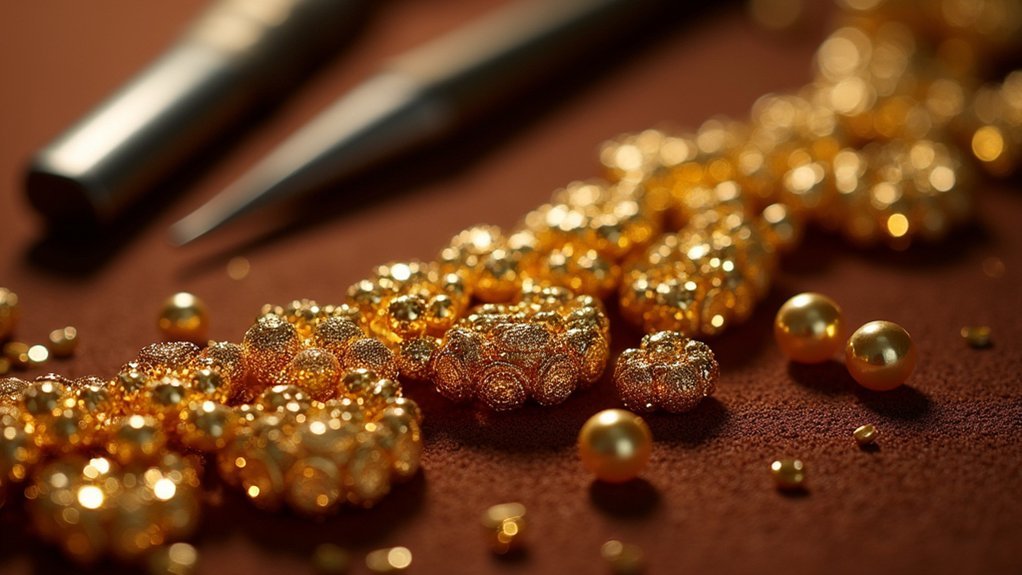
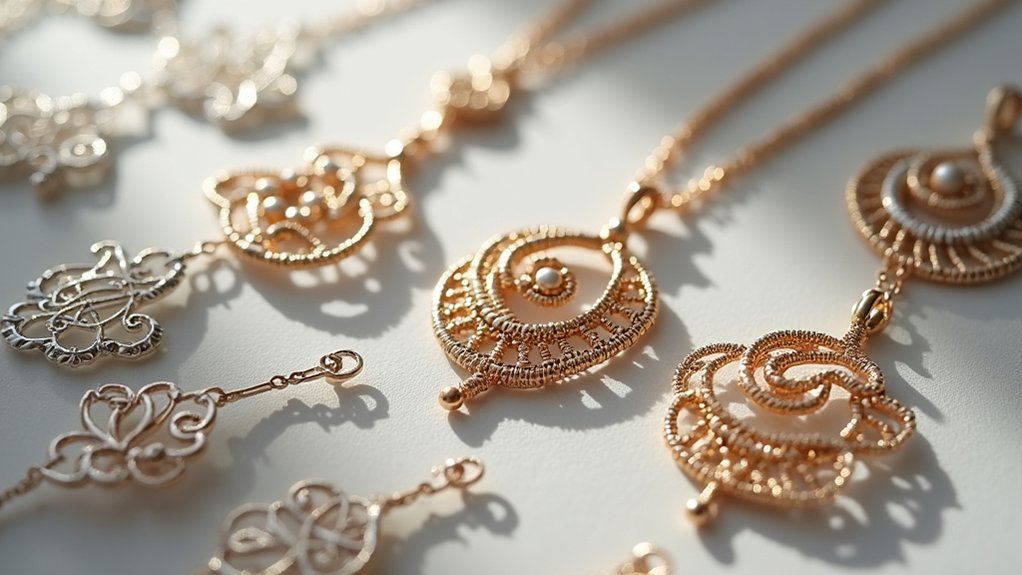
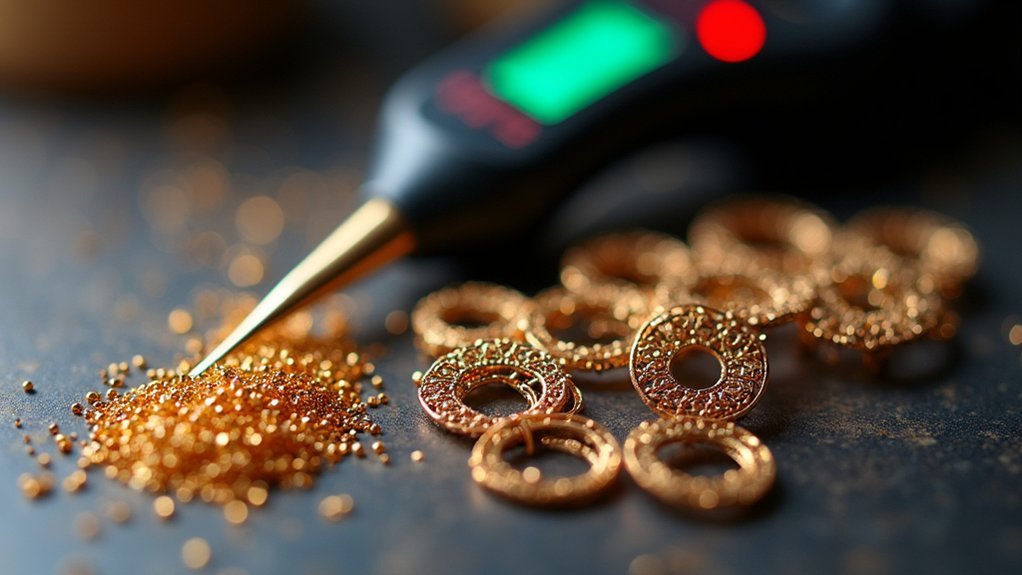
Leave a Reply